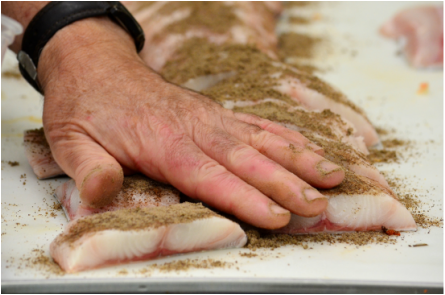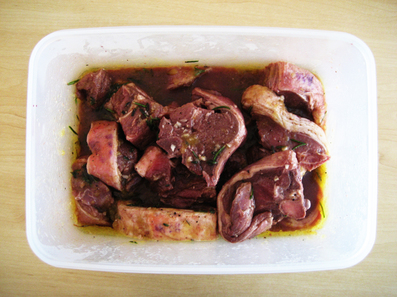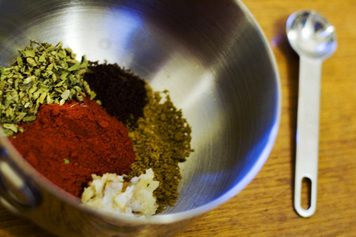"Phil, if you ever eat boring food, I will disown you."
Well, actually, she didn't say that, not out loud at least. That said, she did instill enough fear in me through well timed side eye and caring yet firm "Mhm..."s while she watched me cook to make me never cook anything for myself that I wouldn't serve to guests.
It was through this fear...err...encouragement that I started to find new ways to make my food tastier, brighter, and more interesting. I made plenty of sauces and dressings, but eventually, I had to draw myself away from the instant gratification of quick pan sauces and come to appreciate the tried and true slow method that is the marinade.
When made with care, marinades let you get creative at a level few other methods of flavouring your food can. While there are no hard and fast rules when it comes to building a marinade, there are some rough guidelines and ratios that lend themselves to marinade success.
For most marinades, a fat to acid to flavorings ratio of 2:1:1 is a good rule of thumb.
The next major components of a marinade is an acid. Be mindful to keep your acids in check when building your marinade. Too much, and you'll feel like you're eating a Warhead. Add too little, and your food may be very one-noted or bland. Get it right, and you'll be rewarded with a brightness and zest to your food no other flavours can provide. What qualifies as an acid is pretty broad - while things like lemon juice and vinegar count, buttermilk, other fruit juices, and even yogurt can play the role of an acid in a dish. In addition to the tanginess it brings to dishes, acids also help to tenderize some otherwise tougher cuts during the marinating process. Be careful though, adding too much acid can break down some meats too much, especially already tender cuts like pork and beef tenderloin; this can turn them mushy when they are cooked.
The final part of a good marinade is "flavorings". This is where you can get creative. This can be any mix of ingredients: Sweets like sugar, jams, and honey, aromatics like ginger, garlic, and onion, and herbs and spices like cinnamon, cumin, and rosemary all fall in this category. Choose your flavorings wisely so they will complement each other. Some combinations like Sriracha, nutmeg, and thyme may not make sense, while honey, soy sauce, and ginger may play quite well together. Do not treat your marinade as a dumping ground for whatever leftover spices and odds and ends you find in your refrigerator. You'll likely end up with a muddied mess of flavours that no food will take on well. One thing that you should also be sure to include however is some kind of salt in this part of your marinade. This can mean regular table salt or salty sauces like soy or fish sauce. Few things can make a marinade fall flat like a lack of salt.
Looking for more inspiration? Check out my previous post regarding Flavour Foundations that goes over how some common flavor combination built the bases for many famous dishes and cuisines today.
Assembling Your Marinade
Cooking
When you're done marinating and ready to cook, remove your food from the marinade, and optionally, dry off any excess liquid from the surface of your food with some paper towel. Throw out any remaining marinade that has been in contact with your raw meat. The last thing you want is to feel like you've been gut punched and be stuck heaving over your toilet all night due to food poisoning. If you want to reserve marinade to brush on your food while cooking or to use as dipping sauce, reserve some clean marinade in a separate container right after you finish assembling it.
Dry Rubs are a combination of salt, spices, and other flavorings that are, you guessed it, massaged ever so caringly into meat to impart flavour when cooked. You often hear dry rubs talked about in context of barbecue. Like marinades, rubs have a built-in flexibility in their composition that allows for chefs to make their own mark on their food. One of the most common ratios for dry rubs comes from Alton Brown, who proposed the 8-3-1-1 combination of sugar - salt - spice - other flavourings. You can read more about it here.
Wet Rubs happen when a dry rub accidentally leaves the house without bringing an umbrella and it starts storming during their evening commute home. In reality, wet rubs build on the base of dry rubs and instead of being rubbed on meat dry, a base, usually oil, is mixed with the salt, spices, and other flavorings and them massaged into the meat. I tend to cut the sugar for wet rubs versus dry rubs but that is mostly personal preference. For the most part, you want to keep the rub at around or slightly less than 1/2 oil by volume to your salt and spices. You don't want your rub too liquid or it may become difficult to work with. Follow a similar refrigeration and marinading time for your wet and dry rubs as you would your marinades.
I hope this brief overview of marinades and wet and dry rubs has helped demystify some ways you can bring a little more flavour into your everyday cooking routines. A wet rub is exactly what I used when I recently made a Cuban Inspired roast pork loin recently. Yes, it is probably about as authentically Cuban as sliced spam topped with Cholula, but the blend of spices did remind me of a similar dish I had at a Cuban restaurant while travelling in the Caribbean a while back. To accompany it, I made a vegetable filled rice and beans. Give it a try!
The recipes are as follows:
1 - 2-2.5lb Pork Sirloin Roast
Wet Spice Rub:
2 Tablespoons Vegetable Oil
1 Tablespoon Salt
2 teaspoons paprika
1 teaspoon chili powder
1 teaspoon cumin
1/2 teaspoon black pepper
1/2 teaspoon garlic powder
1 teaspoon lime juice
Black Beans and Rice
1 - 1lb bag of brown rice
1 red bell pepper, chopped
1 yellow bell pepper, chopped
1 yellow onion, chopped
1 Serrano pepper, de-seeded and finely minced
1 tablespoon vegetable oil
1 teaspoon bacon fat (or substitute oil if not available)
1 can of black beans, liquid included
3-3.5 cups water
1 large handful of cilantro, chopped
salt and pepper to taste
Roast Pork Directions
1. Combine wet rub ingredients in a large bowl. Add in the pork loin and massage meat with the wet rub to coat evenly. Cover and let marinade in the refrigerator for at least 2 hours.
2. Pre heat oven to 400 degrees Fahrenheit
3. Prepare roasting pan by coating with a little oil. Transfer the pork in to the roasting pan and put it in the oven for 1hr15m - 1hr30m or until the interior reaches 150 degrees. After, remove from the oven, cover with foil, and let rest for at least 10 minutes before slicing.
Black Beans and Rice Directions
1. Prep and chop all the vegetables to the sizes listed above.
2. In a large pot, pre-heat oil and bacon fat over medium-high heat until shimmering
3. Add in all the vegetables, season with a little salt, and sauté until tender - about 5 minutes
4. Add in the rice and toss to coat in oil - about 1 minute
5. Add in the black beans and water. Cover and bring to a boil over high heat. Then reduce to low heat and cook until water is absorbed and the rice is the desired consistency - about 45 minutes to 1 hr.
6. Stir in chopped cilantro and season to taste with extra salt and pepper.
7. Serve with hot sauce and sour cream if desired.




